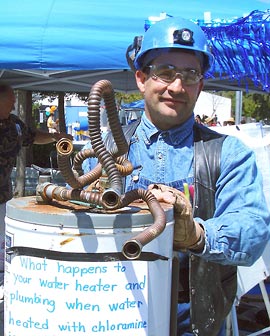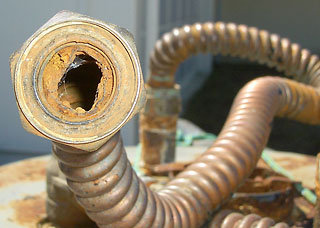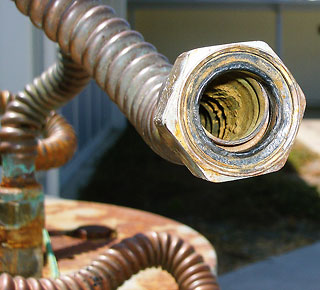
San Francisco Bay Area, California 408 227-5767
Photographs Showing the Corrosive Effect of Chloramine on Water Heater Pipes
Articles on Lead in Drinking WaterArticle in Newspaper
The following article first appeared in The Almanac (Menlo Park, CA) on Wednesday, May 17, 2006.
Water additive causing rise in plumbing problems
 Tradesman Ken Russo, who says he suffers respiratory and skin problems resulting from chloramine in the water, points to another "cause and effect" of the chemical additive: a dramatic increase in plumbing problems.
Tradesman Ken Russo, who says he suffers respiratory and skin problems resulting from chloramine in the water, points to another "cause and effect" of the chemical additive: a dramatic increase in plumbing problems.
Callers desperate for help with leaks, broken pipes and busted water heaters keep his phone ringing all hours of the day, he says.
Although he prefers to work on remodeling projects, "Lately, all I've been doing is a lot of plumbing."
Mr. Russo attends Citizens Concerned About Chloramine community presentations equipped with a 20-gallon water heater he uses to show the corrosive effects of chloramine.
The SFPUC acknowledges on its Web site that "the lead corrosion concern associated with chloramine is something new and unexpected both by the regulators and the industry." And chloraminated waters "are more aggressive" than chlorine in reacting with rubbers and their derivatives.
Mr. Russo says rubber fittings and polyurethane fixtures lose their elasticity and are "more prone to cracking" because of chloramine.
"Parts are corroding and failing at an accelerated rate," he says.
The SFPUC notes on its Web site that chloramine-resistant toilet flapper valves and washers can be purchased at hardware and plumbing supply stores.
—By Renee Batti
Water additive causing rise in plumbing problems

Callers desperate for help with leaks, broken pipes and busted water heaters keep his phone ringing all hours of the day, he says.
Although he prefers to work on remodeling projects, "Lately, all I've been doing is a lot of plumbing."
Mr. Russo attends Citizens Concerned About Chloramine community presentations equipped with a 20-gallon water heater he uses to show the corrosive effects of chloramine.
The SFPUC acknowledges on its Web site that "the lead corrosion concern associated with chloramine is something new and unexpected both by the regulators and the industry." And chloraminated waters "are more aggressive" than chlorine in reacting with rubbers and their derivatives.
Mr. Russo says rubber fittings and polyurethane fixtures lose their elasticity and are "more prone to cracking" because of chloramine.
"Parts are corroding and failing at an accelerated rate," he says.
The SFPUC notes on its Web site that chloramine-resistant toilet flapper valves and washers can be purchased at hardware and plumbing supply stores.
—By Renee Batti
Photographs Showing the Corrosive Effect of Chloramine on Water Heater Pipes



Top photo: corrosion on top of water heater caused by leak
Second photo: hot water output pipe
Third photo: cold water intake pipe
Note that heated chloraminated water is much more corrosive than cold chloraminated water.
Second photo: hot water output pipe
Third photo: cold water intake pipe
Note that heated chloraminated water is much more corrosive than cold chloraminated water.
Articles on Lead in Drinking Water
Imminent Endangerment: "Lead" Astray by the EPA. Princeton University Lecture Series, May 4, 2006
Marc Edwards, Virginia Polytechnic Institute
The Water Guy. First, Marc Edwards discovered high levels of lead in Washington, D.C.'s, drinking water, then he had to persuade the bureaucracy to get the word out. November 2004
Pierre Home-Douglas, Prism, American Society for Engineering Education
Several U.S. Utilities Being Investigated for Lead, October 14, 2004
Water Agencies Have Hidden or Misrepresented Test Results, Records Show
Carol D. Leonnig and David Nakamura, Washington Post Staff Writers
Chloramines again linked to lead in drinking water, June 29, 2005
Rebecca Renner, Environmental Science & Technology, Science News
Experiment confirms chloramine's effect on lead in drinking water. The water chemistry that caused Washington, D.C.'s lead problem isn't unique. April 12, 2006
Rebecca Renner, Environmental Science & Technology, Science News
Mis-lead. Water utility managers and public-health officials may be getting the wrong message about what happened during Washington, D.C.'s drinking-water crisis. May 31, 2006
Rebecca Renner, Environmental Science & Technology, Science News
Written Testimony by Marc Edwards, Professor of Civil Engineering, on lead in the drinking water of the District of Columbia Water and Sewer Authority (DC WASA), to the U.S. House of Representatives, Chairman Tom Davis and the Committee on Government Reform, March 5, 2004
Marc Edwards, Virginia Polytechnic Institute
- Streaming WebMedia: https://mediacentral.princeton.edu/media/
Imminent+EndangermentA+%27Lead%27+Astray+by+the+EPA/
1_gqyv8cmv
The Water Guy. First, Marc Edwards discovered high levels of lead in Washington, D.C.'s, drinking water, then he had to persuade the bureaucracy to get the word out. November 2004
Pierre Home-Douglas, Prism, American Society for Engineering Education
Several U.S. Utilities Being Investigated for Lead, October 14, 2004
Water Agencies Have Hidden or Misrepresented Test Results, Records Show
Carol D. Leonnig and David Nakamura, Washington Post Staff Writers
Chloramines again linked to lead in drinking water, June 29, 2005
Rebecca Renner, Environmental Science & Technology, Science News
- HTML, original article: http://web.archive.org/web/20080415104924/
http://pubs.acs.org/subscribe/journals/esthag-w/ 2005/jun/science/rr_chloramines.html - PDF (semi-monthly issue):
August 1, 2005, Vol. 39 Issue 15, pg. 314A
https://pubs.acs.org/doi/pdf/10.1021/es053317d
Experiment confirms chloramine's effect on lead in drinking water. The water chemistry that caused Washington, D.C.'s lead problem isn't unique. April 12, 2006
Rebecca Renner, Environmental Science & Technology, Science News
- HTML, original article: http://web.archive.org/web/20060614183639/
http://pubs.acs.org/subscribe/journals/esthag-w/ 2006/apr/science/rr_chloramines.html - PDF (semi-monthly issue):
May 15, 2006, Vol. 40 Issue 10, pages 3129-3130
https://pubs.acs.org/doi/pdf/10.1021/es062689z
Mis-lead. Water utility managers and public-health officials may be getting the wrong message about what happened during Washington, D.C.'s drinking-water crisis. May 31, 2006
Rebecca Renner, Environmental Science & Technology, Science News
- HTML, original article: https://web.archive.org/web/20071114203057/
http://pubs.acs.org/subscribe/journals/esthag-w/ 2006/may/science/rr_mislead.html - PDF (semi-monthly issue):
July 15, 2006, Vol. 40 Issue 14, pages 4333-4334
https://pubs.acs.org/doi/pdf/10.1021/es062989g
Written Testimony by Marc Edwards, Professor of Civil Engineering, on lead in the drinking water of the District of Columbia Water and Sewer Authority (DC WASA), to the U.S. House of Representatives, Chairman Tom Davis and the Committee on Government Reform, March 5, 2004
- PDF file (with illustrations): http://www.safedrinkingwater.com/community/2004/ VTEdwardsTestimony.pdf (467 KB)
- HTML (without illustrations): http://www.dcwatch.com/wasa/040305h.htm
- PDF file on this website (with illustrations): VTEdwardsTestimony.pdf (467 KB)